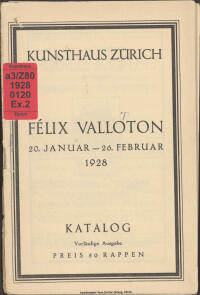Félix Vallotton
20.01.1928 – 26.02.1928
Location Kunsthaus.
Location Kunsthaus.
When the Visible Becomes Tangible
Félix Vallotton, the painter, graphic artist, and writer born in Lausanne in 1865, moved to Paris in his early years, where he took French citizenship and died in 1925, in the city on the Seine, as a result of an operation. Three years after his death, the Kunsthaus devoted a comprehensive exhibition to the artist. In addition, he weas presented to the Zurich Art Society in two New Year papers by the collector, Hedy Hahnloser.
Of some 1700 documented paintings by this artist, the exhibition in the Kunsthaus brought together about 180 pictures, which had been produced in a period of more than five decades. In addition to these works, there were also some drawings and three bronzes to be seen. The majority of the works came from private collections in Lausanne and Winterthur, including from the collection of Hedy and Arthur Hahnloser, who had been collecting his work since the beginning of the twentieth century. At the start of the exhibition, placed in the side rooms, the visitor found the “Old Man, Study of Head” (1882), which Félix Vallotton had made as a seventeen-year-old. The exhibition ended, a productive and very successful artist life later, with Woman at her Toilette (1925). In between one could admire numerous nudes, interiors, still lifes, and landscapes, which the artist brought to effectiveness not only as a master of the linear but also as an individualist colorist.
In the Tages-Anzeiger the “mastering of the materials” was described as a feature of Valloton’s work: “The visible becomes not only a realistic vision, it becomes tangible.” At the same time, however, he was said to have “little imagination” as shown by the often summary treatment of the background. What is today seen as a sign of modernity was apparently then still taken to be a weakness. The Zürcher Post called hm an artist who was “of considerable importance for the history of modern painting.” Only his sometimes rather shrill coloring was objected to. The NZZ maintained in contrast: “The artist mastered color in the portraits, in the figure images, in the landscape and in still life […] What precious tints of color […] how color comes to life with him!”
The exhibition was accompanied with a catalog including a list of works.
[Peter Stohler]
Further information
In the Tages-Anzeiger the “mastering of the materials” was described as a feature of Valloton’s work: “The visible becomes not only a realistic vision, it becomes tangible.” At the same time, however, he was said to have “little imagination” as shown by the often summary treatment of the background. What is today seen as a sign of modernity was apparently then still taken to be a weakness.
37 days
1 Artist
1 Artist

exhibition catalog